Centauri Dreams
Imagining and Planning Interstellar Exploration
SETI in the Anthropocene
Have we, as some have argued, entered a new ‘age of humanity,’ the so-called Anthropocene? The notion is controversial in many quarters, but it addresses the growing concern about our human influence on the Earth and the nature of planetary change. David Grinspoon’s new book Earth in Human Hands (Grand Central Publishing, 2016) has much to say about the Anthropocene, but as anyone who has read the work of this canny scientist knows, he’s not one to let facile assumptions get by unquestioned.
For if the activity of humans is now emerging as an agent of geological change, then we are discussing our civilization in the same terms we talk about planetary forces like tectonic movement and the carbon cycle. This makes us major players whose effects we can begin to chart in terms of the effects of our technology on Earth’s living systems. If the Anthropocene is happening, it presents us not only with danger but the prospect of a long-term future. And its implications take in not just our movement into space but our search for other civilizations.
Hence Grinspoon’s view that while we are leaving an unmistakable footprint on our planet’s living substrate, this is not something to be deplored as much as understood and put to good use, the theory being that living things have always shaped the world around them, in ways as profound as the Great Oxygenation Event of 2.5 billion years ago. Earth in Human Hands is rich in discussion of what it would be like to enter what Grinspoon calls the ‘mature Anthropocene,’ in which humans acting wisely and with long-term horizons learn to use technology to repair past damage and introduce a new era of planetary stability.
In this view, our current dilemma is that we are achieving global impact without any sense of global control. The analysis is filled with Grinspoon’s experience as an astrobiologist and it draws together themes that are at the heart of how we consider our own future and how we look at other civilizations. For make no mistake, when we examine SETI, we’re forced to address questions like the lifespan of a technological civilization. If such societies persist, how do they do it, and equally of interest, what sort of signature would they leave? Stanislaw Lem comes to mind, and Grinspoon quotes him from his Summa Technologiae:
We need to overcome the habit of considering outcomes of human activity as more imperfect than those of nature’s activity — understandable as such a habit may be at the current stage of development — if we are to talk about what is going to happen in a faraway future.
Are we not ourselves a part of the nature we study, and rather than deploring the fact, should we not be considering how to make our own contribution to the mindfulness that intelligent life brings to the universe? You may pick up a bit of Sagan in these themes, particularly the Sagan (and Shklovskii) of the 1966 masterwork Intelligent Life in the Universe. The connection is borne out by Grinspoon’s relationship with Sagan, who worked with the author’s father at Harvard and shaped his boyhood and early career. No wonder Sagan and Shklovskii’s influence on SETI play such a vital and entertaining role in his book.
A Third Route for SETI
A confluence of events marks the beginning of SETI, with Frank Drake’s early efforts at Project Ozma following swiftly after the famous “Searching for Interstellar Communications” paper by Giuseppe Cocconi and Philip Morrison. But I think you could say that the discipline put down its formative roots at two conferences, the first being the one Drake hosted at Green Bank in 1961, the second the First All-Union Conference on Extraterrestrial Civilizations and Interstellar Communication, which was held in 1964 at the Byurakan Astrophysical Observatory in Soviet Armenia. Between the two we see a foundational SETI defined.
Frank Drake’s famous equation emerged from Green Bank, a conference with only 11 attendees that took SETI out of the realm of theory and into observational science. At Byurakan, Iosif Shklovskii criticized the Cocconi and Morrison paper for being too restrictive — the authors, Shklovskii argued, assumed that extraterrestrial civilizations would be on approximately the same level as ourselves. Shklovskii believed that any civilizations we detected would be far more advanced technologically than ourselves, for “We are only infants as far as science and technology are concerned,” and technology’s growth is rapid.

Grinspoon’s treatment of SETI is relaxed and knowledgeable, but it is the weaving of the anthropocene theme into SETI’s subsequent development that gives these chapters punch. For Nikolai Kardashev, then a young student of Shklovskii’s, was also at Byurakan to make the case for his three types of technological civilization, based on what he saw as a predictable and steady increase in the use of energy. Thus the categories most Centauri Dreams readers have come to be familiar with:
Type I: A civilization that can use all the energy resources of its own planet.
Type II: A civilization using all the energy resources available from its star. This is a civilization that has mastered its own stellar system and travels readily in space.
Type III: A civilization that can harness the energy of its entire galaxy. This is obviously an interstellar culture that moves freely between stars.
Image: Astrobiologist and author David Grinspoon, now a senior scientist at the Planetary Science Institute in Tucson.
We have often considered in these pages how advanced civilizations might present themselves to a distant observer; i.e., what kind of signature their engineering might leave in star systems and, indeed, in entire galaxies. Searches for Dyson spheres and odd stellar phenomena like the light curves of KIC 8462852 (Boyajian’s Star) continue to push the boundaries of radio and optical SETI. At a second conference in Byurakan, put together by Sagan and Shklovskii following the success of their book, the discussions of advanced technologies clustered around the Kardashev scale and its potential observables.
Radio and optical SETI, the first level of SETI, are complemented by a Dysonian SETI (level 2) that looks through our astronomical data for the signs of technological activity. But Grinspoon points out the key assumption of the Kardashev scale: That civilizations will inevitably increase their energy use in order to fuel a continuing expansion into the cosmos.
This is an idea of progress that is generally accepted — Grinspoon calls it the ‘inevitable expansion fallacy’ — but it is one that doesn’t take into account that key term (L in Drake’s equation) about the lifetime of a technological civilization. What if, in short, expanding in the Kardashev manner is the most likely way to end the growth of a culture?
A third level of SETI now emerges. You can see how Grinspoon is tying this back into the idea of an Anthropocene epoch on Earth. Let me quote him on this:
…it is reasonable to suppose that truly successful, long-lived species have all discarded the expansion imperative, and replaced it with an ethic of sustainability, of valuing longevity of expansion. If technological intelligence has a true and lasting form, one of its basic properties must be that it moves beyond the exponential expansion phase (characteristic of simple life in a petri dish or on a finite planet) before it hits the top of the S-curve and crashes. For us, achieving this kind of planetary intelligence will require critically examining our inherited biological habits and shedding those that have become liabilities.
And what exactly does a planetary intelligence involve? Grinspoon explains it as:
…thoughtful control over one’s self, escape from the mindless drives to multiply, to expand, to lay waste, kill, and drown in your own waste. Perhaps this is why we will not find what Shklovskii called ‘miracles,’ the highly visible works of vastly expanded super-advanced civilizations. Because advanced intelligences are not stupid.
At this point, we’ve stood Kardashev’s ideas on their head, for what Grinspoon is saying is that the kind of technological intelligence that lasts is one that has the ability to overcome its biological need for exponential growth. If this is the case, then we are confronted with the possibility that the more advanced a technological civilization becomes, the less likely we will be to distinguish it from natural phenomena. We may confront a cosmos rife with advanced civilizations whose work is so harmonized with their surroundings as to be invisible.
In earthly terms, the ‘mature Anthropocene’ is where we begin to move out of the era when the changes we make to our planet are beyond our comprehension, and into the era when we begin to consciously shape the Earth’s future, a time when, as Grinspoon writes:
…we fully incorporate our uniquely human powers of imagination, abstraction, and foresight into our role as an integral part of the planetary system. The mature Anthropocene differentiates conscious, purposeful global change from the inadvertent, random changes that have largely brought us to this point.
In SETI terms, consider the Anthropocene a metaphor for what can happen on other worlds. As we first confront the danger of technological over-reach in our environment and then learn to heal the wounds that limit sustainable growth, we may turn toward a balance that sustains our planetary ecology while ensuring the survival of our civilization. What Grinspoon calls the ‘Sapiezoic’ eon would be the long-lived stage of technological civilization that leads conceivably to immortality. Exponential expansion may simply be an evolutionary dead end, and the likelihood of finding civilizations that are learning this lesson the hard way is vanishingly small. They are simply not in existence long enough for us to see them.
Do we have a chance at detecting a civilization that operates according to the long-term model? Let’s talk about that tomorrow as we continue to look at this third route for SETI. We’ll also see that in Grinspoon’s view, expansion into space has a major role to play in the survival of long-haul civilizations. Developing a stable relationship with world-changing technologies is the key.

Nearby Super-Earth at GJ 536
The discovery of a super-Earth of about 5 Earth masses orbiting the star GJ 536 is a helpful addition to our catalog of nearby red dwarf planets. About 33 light years out, GJ 536b orbits its primary at a distance of 0.06661 AU, an 8.7 day orbit that is too close to be in the habitable zone. But its very proximity to the star implies the possibility of a transit, which could pay big dividends in spectroscopic studies of its atmosphere. Follow-ups as soon as next year should tell us whether it does in fact transit.
The work comes out of the Geneva Observatory, working with researchers in France and Portugal, and involves data from the HARPS (High Accuracy Radial velocity Planet Searcher) spectrograph on the European Southern Observatory’s 3.6 meter telescope at La Silla (Chile). And it has me thinking about the problems and benefits of red dwarf studies. For one thing, astronomers can use nearby M-dwarfs for exoplanet detection because the low mass of the star offers up a robust radial velocity signal — RV was the method used in this detection.
But as the paper on this work notes, M-dwarfs also produce plentiful activity on the surface, which can not only introduce noise into the signal but can actually mimic a planetary signature. Tread carefully in this region, in other words, and be wary of false positives. Thus the research team, headed up by Alejandro Suárez Mascareño (Instituto de Astrofísica de Canarias), also reports a second significant radial velocity signal at 43.8 days which can be readily ruled out:
The second radial-velocity signal of period 43.8 d and semi amplitude of 1.6 ms?1 is a magnetic activity induced signal related to the rotation of the star. We also found a magnetic cycle shorter than 3 yr which would place this star among those with the shortest reported magnetic cycles.
As with our own Sun, whose magnetic cycle runs to 11 years, we’re looking at stellar activity that can alter the star’s radiation, produce starspots and perhaps produce flares.
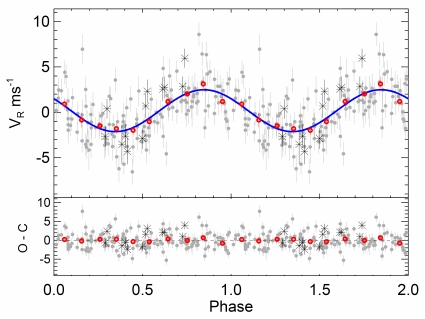
Image: Radial velocity signal of a planet. This is Fig. 10 from the GJ 536b paper, captioned “Phase folded curve of the radial velocity using the 8.7 d period. Grey dots are the raw radial-velocity measurements after subtracting the mean value and the 43.9 d signal. Credit: Mascareño et al. (citation below).
Let’s back out to a broader picture for a moment. Although the Kepler instrument as well as numerous radial velocity and transit studies by ground-based telescopes have given us a priceless catalog of planets, we’re still talking about no more than about a hundred confirmed planets around M-dwarfs. Of these, only a subset consists of rocky planets. We do see systems with Neptune-mass planets and super-Earths, not to mention a few planets near Earth mass, the most spectacular being the world around Proxima Centauri.
We don’t have nearly as much hard data about the frequency of rocky planets around M-dwarfs as we would like, which is why I pay so much attention to such discoveries. We’d like to learn more about the probabilities, particularly in light of work like that of Ravi Kopparapu, who reported in these pages back in 2014 about his own estimate. The Penn State scientist recalculated work by Harvard’s Courtney Dressing and David Charbonneau and came up with what he calls a ‘conservative’ estimate that 48 percent of M-dwarfs should have Earth-size planets in the habitable zone. In other words, an impressive 1 out of every 2.
Given that 75 to 80 percent of the stars in the galaxy are M-dwarfs, this opens up vast numbers of possibly habitable worlds. You can refresh your memory on Kopparapu’s work in How Common Are Potential Habitable Worlds in Our Galaxy, which also discusses the probabilities of habitable planets around G-class stars like our Sun (Kopparapu discusses estimates of about 1 in 5 but believes they are too low). In any case, we need to do with small rocky worlds around nearby stars what we did with the Kepler field stars; i.e. we need to pull in enough data to build up a significant statistical sample. Upcoming missions like TESS (Transiting Exoplanet Survey Satellite) are vital, while the James Webb Space Telescope should be able to analyze the kinds of gases present in the atmospheres of planets around M-dwarfs.
Back to GJ 536b: The authors calculate that for a planet to be in the habitable zone of GJ 536, it would have to orbit in no less than 20 days. At 8.7 days, GJ 536b is too close to the star for habitable conditions to exist. But note this:
The stability of its rotation signals and the low amplitude of the radial-velocity signals with a magnetic origin makes this star a good candidate to search for longer period planets of moderate mass. A rough estimate of the detection limits tells us there is still room for Earth-like planets (? 1 M?) at orbits smaller than 10, super-Earths (< 10 M?) at orbits going from 10 to 400 days, and even for a Neptune mass planet (< 20 M?) at periods longer than ?3 yr.
So the hunt for planets around GJ 536 is clearly not over. We can expect the action to heat up for red dwarf planets in the solar neighborhood as we get new assets into space and continue developing the next generation of ground-based telescopes. If planets in the habitable zones around these stars are as plentiful as some scientists think, we’ll count on spectroscopic analysis of many an atmosphere to give us clues about the possibility of life.
The paper is Mascareño et al., “A super-Earth orbiting the nearby M-dwarf GJ 536,” accepted at Astronomy & Astrophysics (preprint).

Fast Radio Bursts as Cosmological Probes
One of the brightest Fast Radio Bursts seen since the phenomena were first detected in 2001 has been observed by the Parkes radio telescope in New South Wales. Maybe it should come as no surprise that Parkes was involved, given that most of the 18 FRBs that have so far been detected have been found there, including the so-called ‘Lorimer’ burst of 2001, which launched researchers’ interest in these mysterious processes. This one is thought to be particularly helpful in constraining magnetic fields and gases in intergalactic space, for observed distortions produced by an FRB’s travel yield data about the medium.
Ryan Shannon (ICRAR-Curtin University), a co-author of the paper, refers to the region between the galaxies as the ‘cosmic web,’ a region of all but invisible gases and plasma particles that is extremely hard to map. FRBs are short but intense pulses of radio waves — each lasts about a millisecond — that are usually discovered by accident, and no two look the same. Radio pulse FRB 150807, however, may be uniquely useful because its travel path can be traced back to an area in space that contains only a small number of stars and galaxies.
“This FRB, like others detected, is thought to originate from outside of Earth’s own Milky Way galaxy,” says Shannon, “which means their signal has travelled over many hundreds of millions of light years, through a medium that – while invisible to our eyes – can be turbulent and affected by magnetic fields. It is amazing how these very few milliseconds of data can tell how weak the magnetic field is along the travelled path and how the medium is as turbulent as predicted.”

Image: The radio pulse FRB 150807. The colour shows the frequency of the waves, which is like the colour of light. The brightness varies with frequency due to a process termed “scintillation”, which is caused by the twinkling of the burst in the cosmic web. This scintillation is the fingerprint of turbulence in the cosmic web and tells us that web is very placid. Credit: Dr Vikram Ravi/Caltech and Dr Ryan Shannon/ICRAR-Curtin/CSIRO.
So we have a probe of sorts of the intergalactic medium, one that was detected in 2015 and has now made its way into the literature. But just how deeply can we probe this region with FRBs? The paper argues that the bursts thus far studied may revolutionize cosmology, a bold claim, but one based on the information within FRBs that may be obtained in no other way.
From the paper:
Besides probing a heretofore-unknown astrophysical phenomenon, the bursts potentially carry imprints of propagation through inhomogeneous, magnetized plasma in the ionized interstellar media of other galaxies, and the diffuse intergalactic medium (IGM). Simultaneous measurements of redshifts and line-of-sight free electron column densities for FRBs can constrain the cosmological mass-density and ionization history of baryons.
Using FRBs as cosmological probes has been made difficult by the uncertainty about their origins, which is why FRB 150807 is so helpful — we can reconstruct its path. The archival images the team is using show three stars and six galaxies that are possible sites (see image below). The brightest galaxy is between 1 and 2 gigaparsecs away — roughly between 3.3 and 6.6 billion light years. The other galaxies are fainter than this object by factors of 6 and more, and all are thought to be more than 500 Mpc (1.6 billion light years) distant. This assumes, of course, that we can associate the burst with a star or a galaxy.
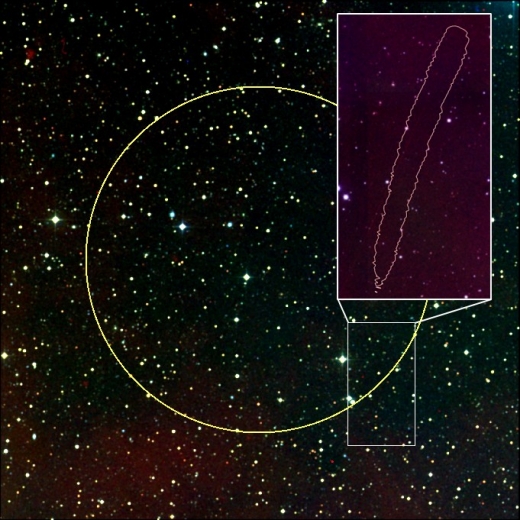
Image: The location of the FRB 150807. The yellow circle shows the typical location of an FRB. There are thousands of stars and galaxies in this direction. Because the burst was very bright researchers were able to locate it to a small region near the edge of that circle, shown as the pink banana-shaped region in the inset. In this region there are only 6 detected galaxies. The position of the most likely host galaxy, VHS7, is highlighted on the plot. Credit: Dr Vikram Ravi/Caltech and Dr Ryan Shannon/ICRAR-Curtin/CSIRO.
A supercomputing group led by Matthew Bailes (Swinburne University of Technology) produced the software that has been used in the analysis of the burst. The hope among the researchers is that technologies like Parkes’ multibeam receiver, the Murchison Widefield Array (MWA) in Western Australia, and the upgraded Molonglo Observatory Synthesis Telescope near Canberra can be used to detect and study future FRBs.
“Ultimately, FRBs that can be traced to their cosmic host galaxies offer a unique way to probe intergalactic space that allow us to count the bulk of the electrons that inhabit our Universe,” said Bailes. “To decode and further understand the information contained in this FRB is an exceptional opportunity to explore the physical forces and the extreme environment out in space.”
And get this: Lead author Vikram Ravi (Caltech) believes that there are between 2,000 and 10,000 FRBs occurring in the sky every day, with one in 10 being as bright as FRB 150807. We’ll take a step forward in finding the locations of these bursts when the Deep Synoptic Array also comes online. This array of 10 dishes at the Owens Valley Radio Observatory in California will pinpoint individual galaxies, allowing astronomers to use distance measurements and FRB analysis to further probe this deepest of all deep space.
The paper is Ravi et al., “The magnetic field and turbulence of the cosmic web measured using a brilliant fast radio burst,” published online in Science 17 November 2016 (abstract).

Pluto: Sputnik Planitia Gives Credence to Possible Ocean
We’ve been looking at the idea of an ocean beneath Pluto’s icy surface for some time, including interesting work on the thermal evolution of the dwarf planet’s ice shell from Guillaume Robuchon and Francis Nimmo (University of California at Santa Cruz). Back in 2011, The Case for Pluto’s Ocean looked at their view that the stretching of Pluto’s surface would have clear implications for an ocean kept warm by radioactive decay in the interior. Now Nimmo is back with a post-New Horizons analysis that also points to an ocean.
The key here is Sputnik Planitia, forming part of the heart-shaped feature that was so distinctive during the flyby — think of Sputnik Planitia as the heart’s ‘left ventricle.’ The impact basin here is aligned almost exactly opposite from Charon. We learn in Nimmo’s paper in Nature that there is only a 5 percent chance that the feature’s alignment with Pluto’s tidal axis is by coincidence. To Nimmo and colleagues, the alignment is a dead giveaway that extra mass in the location is indicated. This would cause tidal interactions between Pluto and Charon that oriented Sputnik Planitia opposite the Charon side.
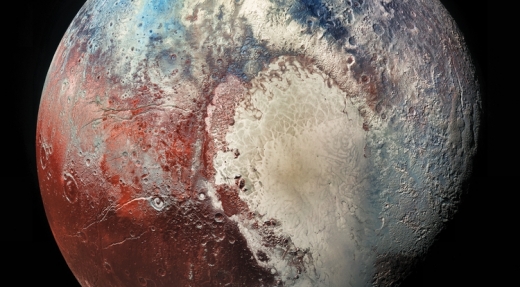
Image: In this image of Pluto taken by NASA’s New Horizons spacecraft, different colors represent different compositions of surface ices, revealing a surprisingly active body. Credit: NASA/Johns Hopkins University Applied Physics Laboratory/Southwest Research Institute.
Thus we’re looking at forces that led to a re-alignment of the two small worlds, and enough mass to make that kind of shift possible. A deep basin doesn’t provide the heft, but an ocean could explain the result. In this way of thinking, Sputnik Planitia is the result of a major impact, which would have been followed by an infusion of water pushing up from below. The ice shell at the top hardens, leaving a deep basin gradually filling with nitrogen ice. Both the nitrogen ice and the water from below are necessary to explain the mass needed.
“It’s a big, elliptical hole in the ground,” says Nimmo, “so the extra weight must be hiding somewhere beneath the surface. And an ocean is a natural way to get that.”

Image: These schematic diagrams show how the gravity anomaly at Sputnik Planitia is affected by an uplifted ocean and the thickness of the nitrogen layer. Either a nitrogen layer more than 40 km thick (panel b) or an uplifted ocean (panel c) could result in a present-day positive gravity anomaly at Sputnik Planitia; otherwise, the gravity anomaly will be strongly negative (panel a). Credit: Nimmo et al., Nature, 2016).
Researchers also believe that the frozen nitrogen ice in the Sputnik Planitia basin may be convecting thanks to a weak spot at the bottom which would let heat rise from the interior. That would be an indication of a thin crust in this area, which would have allowed material from below to push upward to create, along with the nitrogen ice, the extra mass observed.
“Pluto is small enough that it’s just about almost cooled off but still has a little heat, and it’s about 2 percent the heat budget of the Earth, in terms of how much energy is coming out,” says New Horizons co-investigator Richard Binzel (MIT), a co-author of the Nimmo paper. “So we calculated Pluto’s size with its interior heat flow, and found that underneath Sputnik Planitia, at those temperatures and pressures, you could have a zone of water-ice that could be at least viscous. It’s not a liquid, flowing ocean, but maybe slushy. And we found this explanation was the only way to put the puzzle together that seems to make any sense.”
Nimmo believes the subsurface ocean is mostly water mixing with ammonia. This natural ‘anti-freeze’ slows the refreezing of the ocean, but as it continues to freeze, the ocean stresses the icy shell enough to cause the fractures we see in New Horizons imagery. We have images from the flyby that appear to be nitrogen glaciers flowing out of mountainous terrain around Sputnik Planitia, adding credence to the idea that the impact basin filled with nitrogen that froze out in the higher elevations and gradually migrated downward.
Looking into nitrogen flows on Pluto for this post, I came across a separate study, submitted to Icarus and led by Orkan Umurhan (NASA Ames), that supports the movement of this material near Sputnik Planitia. Note this:
We find that the wavy transverse dark features found along the northern shoreline of Sputnik Planum may be a transitory imprint of shallow topography just beneath the ice surface suggesting the possibility that a major shoreward flow event happened relatively recently within the last few hundred years. Model results also support the interpretation that the prominent darkened features resembling flow lobes observed along the eastern shoreline of the Sputnik Planum basin may be a result of wet nitrogen glacial ice flowing into the basin from the pitted highlands of eastern Tombaugh Regio.
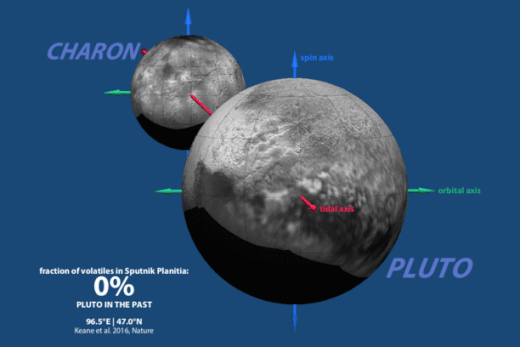
Image: Tip o’ the heart: This animation shows how Pluto reoriented in response to volatile ices filling Sputnik Planitia (the left lobe of Pluto’s “heart”). Sputnik Planitia started northwest of its present position, and as it filled with ices, the tides from Charon (Pluto’s largest moon) caused the entire dwarf planet to reorient. If Sputnik Planitia is still accumulating ice, then Pluto may still be reorienting. Credit: James Keane/NASA/JHUAPL/SWRI).
The same issue of Nature that features the Nimmo work also includes a paper by James Keane and Isamu Matsuyama (University of Arizona), who back the re-orientation idea. In their view, a pileup of frozen nitrogen is what caused Pluto’s ‘polar wander,’ re-orienting it to place extra mass close to the equator. Keane believes Sputnik Planitia continues to accumulate nitrogen as frozen gases sublimate and re-condense on the other side of the dwarf planet, causing seasonal ‘snowfall’ there.
To understand this pattern, remember that Pluto spins on its side, so that the planet’s poles get the most sunlight during the course of a year, while the equatorial region stays permanently cold. Frozen polar gases that sublimate as they warm up during the Plutonian year can play a major role not just in the world’s weather but also in its orientation:
“Each time Pluto goes around the Sun, a bit of nitrogen accumulates in the heart,” Keane said. “And once enough ice has piled up, maybe a hundred meters thick, it starts to overwhelm the planet’s shape, which dictates the planet’s orientation. And if you have an excess of mass in one spot on the planet, it wants to go to the equator. Eventually, over millions of years, it will drag the whole planet over.”
The duo’s computer models, moving Sputnik Planitia and observing the effect on Pluto’s spin axis, bear this out. Thus while Nimmo and team see a subsurface ocean as necessary to explain the position of Sputnik Planitia, Keane and Matsuyama argue for re-orientation keyed to the cycling of volatiles, an adjustment of Pluto’s position that grows out of its weather. Even so, both teams agree that tectonic faults on Pluto are clues to the existence of an ocean.
The Umurhan paper is “Modeling glacial flow on and onto Pluto’s Sputnik Planum,” accepted at Icarus (preprint). The Keane paper is “Reorientation and faulting of Pluto due to volatile loading within Sputnik Planitia,” published online by Nature 16 November 2016 (abstract). The Nimmo paper is “Reorientation of Sputnik Planitia implies a subsurface ocean on Pluto,” published online by Nature 16 November 2016 (abstract).

Project Blue: Imaging Alpha Centauri Planets
We know about an extremely interesting planet around Proxima Centauri, and there are even plans afoot (Breakthrough Starshot) to get probes into the Alpha Centauri system later in this century. But last April, when Breakthrough Initiatives held a conference at Stanford to talk about this and numerous other matters, the question of what we could see came up. For in Alpha Centauri, we’re dealing with three stars that are closer to us than any other. If there are planets around Centauri A and/or Centauri B, are there ways we could image them?
This gets interesting in the context of Project Blue, a consortium of space organizations looking into exoplanetary imaging technologies. This morning Project Blue drew on the work of some of those present at Stanford, launching a campaign to fund a telescope that could obtain the first image of an Earth-like planet outside our Solar System, perhaps by as early as the end of the decade. The idea here is to ignite a Kickstarter effort aimed at raising $1 million to support needed telescope design studies. A $4 million ‘stretch goal’ would allow testing of the coronagraph, completion of telescope design and the beginning of manufacturing.
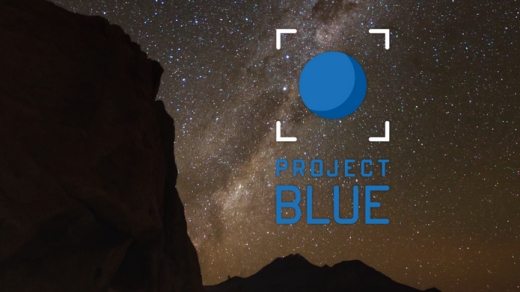
Project Blue thinks it can bring this mission home — i.e., launch the telescope and carry out its mission — at a final cost of $50 million (the original ACEsat was a $175 million design). The figure is modest enough when you consider that Kepler, which has transformed our view of exoplanets, cost $600 million, while the James Webb Space Telescope weighs in at $8 billion. About a quarter of the total cost, according to the project, goes into getting the telescope into orbit, which will involve partnering with various providers to lower costs.
But Project Blue also hopes to build a public community around the mission to support design and research activities. Jon Morse is mission executive for the project:
“We’re at an incredible moment in history, where for the first time, we have the technology to actually find another Earth,” said Morse. “Just as exciting — thanks to the power of crowdfunding — we can open this mission to everyone. With the Project Blue consortium, we are bringing together the technical experts who can build and launch this telescope. Now we want to bring along everyone else as well. This is a new kind of space initiative — to achieve cutting-edge science for low cost in just a few years, and it empowers us all to participate in this moment of human discovery.”
I go back to last April because it was at Stanford that I saw Eduardo Bendek’s model of a small space telescope called ACEsat, which was conceived at NASA Ames by Ruslan Belikov and Eduardo Bendek and submitted (unsuccessfully) for NASA Small Explorer funding. Belikov had gone on to present the work at the American Astronomical Society meeting in 2015 (see “How to Directly Image a Habitable Planet Around Alpha Centauri with a ~30-45cm Space Telescope,” available here). You’ll recall that Ashley Baldwin wrote up the concept in superb detail on this site in December of that year as ACEsat: Alpha Centauri and Direct Imaging.
Now we have Project Blue, which has connections to the BoldlyGo Institute, its offshoot Mission Centaur, the SETI Institute and the University of Massachusetts Lowell. The aim is to launch a space telescope with a 45-50 centimeter aperture, looking for potentially habitable planets from 0.5 to 1.5 AU within the habitable zones of both Centauri A and B. The ultimate hope, then, is to ‘see blue’ — meaning oceans and atmosphere, a world on which life could emerge. This is Sagan’s ‘pale blue dot,’ only now it’s not our own planet but an Earth 2.0.
The Project Blue space telescope would spend two years in low Earth orbit accumulating image after image — hundreds, thousands, tens of thousands — as a way of teasing out its faint targets. When it comes to ‘another Earth,’ Centauri A and B up the ante on Proxima Centauri. The Proxima planet may well be habitable, but a true Earth analog is not going to be tidally locked to its star, as Proxima b probably is, and it’s not going to orbit a red dwarf.
Neither Belikov or deputy principal investigator Eduardo Bendek are formally connected to Project Blue, but their work in the form of papers and conference presentations feeds directly into the concept driving the project. The original mission now cedes the floor to the private sector, whose job it will be to raise enough cash to support the development of the needed coronagraph to filter out the light of two very close stars, along with other key flight hardware elements. The next step, though, long before building flight hardware, is to finalize the telescope design.
The new Kickstarter campaign will pay for analysis, design, and simulations, but Project Blue has an eye on other partnerships as well as wealthy donors and foundations. Usefully, the project should be able to test coronagraph technologies similar to those being considered on much larger space instruments currently under study by the major space agencies, thus providing a useful testbed for such designs. To make this work, everything must fall into place — the coronagraph for starlight suppression, a deformable mirror to feed the coronagraph and rock-solid stability. No aspect can be allowed to fail if the mission is to achieve its goal.
If the Project Blue planners are correct, we can solve the attendant problems and get this mission into space is as little as 4 to 6 years. The goal is hugely ambitious but it also opens the door to citizen-science, with private donors contributing to an instrument that will not be the result of a government program or a for-profit commercial space effort. The initial Kickstarter campaign is designed to bolster the technical groundwork needed for the telescope, but stretch goals could see publicly funded flight component manufacturing.
Looking for Earth-like planets around other stars is like looking for bioluminescent algae next to a lighthouse. But I keep coming back to that Breakthrough Discuss meeting in Stanford, because I remember Ruslan Belikov telling his audience that the key advantage of Alpha Centauri is how large the habitable zones around its component stars appear in terms of angular size. We would need a significantly larger instrument to attempt something similar around other nearby stars. The Alpha Centauri stars are nature’s gift, and it’s one we would do well to exploit. Check the Kickstarter page for more on this low cost, high impact idea.
For more on the technical background of the ACEsat concept, see Belikov et al., “How to Directly Image a Habitable Planet Around Alpha Centauri with a ~30-45cm Space Telescope” (preprint) and Bendek et al., “Space telescope design to directly image the habitable zone of Alpha Centauri” (preprint).

Your Choice of Starships
Think fast. You’ve only got a day or so to work on this. You’ve been asked to come up with a plausible way of getting a fictional crew from one star to another, but laser sails and fusion rockets won’t do. The target might be thousands of light years away, so you have to be thinking faster-than-light. Maybe Miguel Alcubierre comes to mind, or perhaps a wormhole, but a nod in either direction isn’t enough. You’re being asked for a high level of detail, and you’d better have some serious equations available to show you’re not just blowing smoke.
As you might guess, the question relates to the Denis Villeneuve film Arrival, which Paramount released in the U.S. last Friday following its premiere at the Venice Film Festival. No spoilers here, just an entertaining tale. For the person who was asked to dream up fast interstellar transport was Stephen Wolfram, whose public relations people had received a request from the filmmakers to upgrade the science in the film, which was based on a 1998 short story by the brilliant Ted Chiang, a Nebula Award winning short story writer.

As to Wolfram, he heads up Wolfram Research and is the chief designer of both technical computing engine Mathematica and the Wolfram Alpha online presence. In what I might jokingly refer to as his ‘spare time’ he is the author of the recent A New Kind of Science, written during breaks from his work on knowledge-based programming, the latter being an expansion of Mathematica into what is now called the Wolfram Language.
Wolfram, in other words, is a formidable source when it comes to ideas pushing out to the edges of what we know. Intrigued by the challenge of Arrival, Wolfram and son Christopher traveled to Montreal to meet with the film crew. Soon both men were involved with analysis and computations as they turned questions from the director into Wolfram Language code and visualizations. But time was short, and the biggest challenge was coming up with a theory of interstellar space flight in the course of a single evening.
I don’t know if Wolfram is a movie buff or not, but I’d imagine that working this closely with actors and writers and everyone else on the site is enough to make him one. In any case, he’s keen to avoid giving away anything about the film — for that you have to see it — so you can go to his essay Quick, How Might the Alien Spacecraft Work? without concern that it will deflect your enjoyment of a film that is beginning to get a pretty solid buzz (I suspect our resident movie critic Larry Klaes is going to turn up with an essay about this movie, too).
What we get here is only an introduction into the material Wolfram supplied the filmmakers, but it’s intriguing in its own right. It draws from his own speculations about fundamental physics and the lowest level structure of space itself, the idea being that it is, in his words, ‘a network of nodes, where all that’s defined is connectivity.’ Thus space as we perceive it emerges as a large-scale feature even though it’s made up of discrete nodes. He likens this to water, which is made up of discrete molecules but ‘emerges’ as oceans and rivers.
The three-dimensional network underlying the universe, Wolfram supposes for the sake of his model, is made up mostly of local connections, while a few are long-range connections, which correspond to quantum entanglement. The trick is somehow to exploit these long-range connections, which involves disconnecting the outside of the ship from the rest of the network.
This calls for a form of matter that is not made from standard elementary particles, but as Wolfram says, “might be like a giant crystal formed directly from connections that make up space.” Thus the skin of the imagined ship is a dynamic metamaterial, and it is this boundary layer material that creates the needed interaction with the outside universe. And yes, it’s unobtainium, but remember, we’re in a fictional universe studying alien technologies.
We can’t go any further without going into the movie itself, but what comes across in Wolfram’s lively essay is the author’s sheer enjoyment at creating a self-consistent theory that could be referenced in the script. Numerous ideas for science fiction dialogue ensued, most of them not necessary in the actual film, but enlivening in their own right:
Here are a few of the ones that (probably for the better) didn’t make it into the final script. “The whole ship goes through space like one giant quantum particle.” “The aliens must directly manipulate the spacetime network at the Planck scale.” “There’s spacetime turbulence around the skin of the ship.” “It’s like the skin of the ship has an infinite number of types of atoms, not just the 115 elements we know” (that was going to be related to shining a monochromatic laser at the ship and seeing it come back looking like a rainbow). It’s fun for an “actual scientist” like me to come up with stuff like this. It’s kind of liberating. Especially since every one of these science fiction-y pieces of dialogue can lead one into a long, serious, physics discussion.
Wolfram says he got involved in Arrival because Hollywood films all too often don’t get the science input they need, a fact he attributes to directors being more attuned to human conflict and character development than the ‘science texture’ of their movies. But of course we have seen some films with an active science advisor, like Kip Thorne in the recent Interstellar, who conjured up its black hole effects with Mathematica. And (I hadn’t known this), Marvin Minsky worked on artificial intelligence issues for 2001: A Space Odyssey, while mathematician Manjul Bhargava spent years helping to bring The Man Who Knew Infinity to the screen, with careful attention to the math. Agreed, that one isn’t exactly science fiction, being a study of Indian mathematician Srinivasa Ramanujan.
Even so, science fiction in Hollywood hasn’t been known for its history of verisimilitude. Wolfram again:
When I watch science fiction movies I have to say I quite often cringe, thinking, “someone’s spent $100 million on this movie?—?and yet they’ve made some gratuitous science mistake that could have been fixed in an instant if they’d just asked the right person.” So I decided that even though it was a very busy time for me, I should get involved in what’s now called Arrival and personally try to give it the best science I could.
There’s a lot more than starship talk in Wolfram’s essay, especially on establishing communications with an alien intelligence (Wolfram starts with cellular automata), the similarities between software design and movie production, and the possible uses of gravitational waves (massive, spinning non-spherical objects produce them). I keep thinking that with people like Stephen Wolfram involved, the science standards in our films are bound to be on the uptrend presaged by Kip Thorne’s presence in Interstellar.
That could lead to some interesting choices of scripts as we tap the vast store of written science fiction, all too little exploited, for film plots with a genuinely scientific underpinning. Countless short stories and novels form a rich tradition growing out of the science fiction magazines and emerging in the late 20th Century as a vibrant literature in its own right. It’s time Hollywood embarked upon a much deeper acquaintance with this material.



